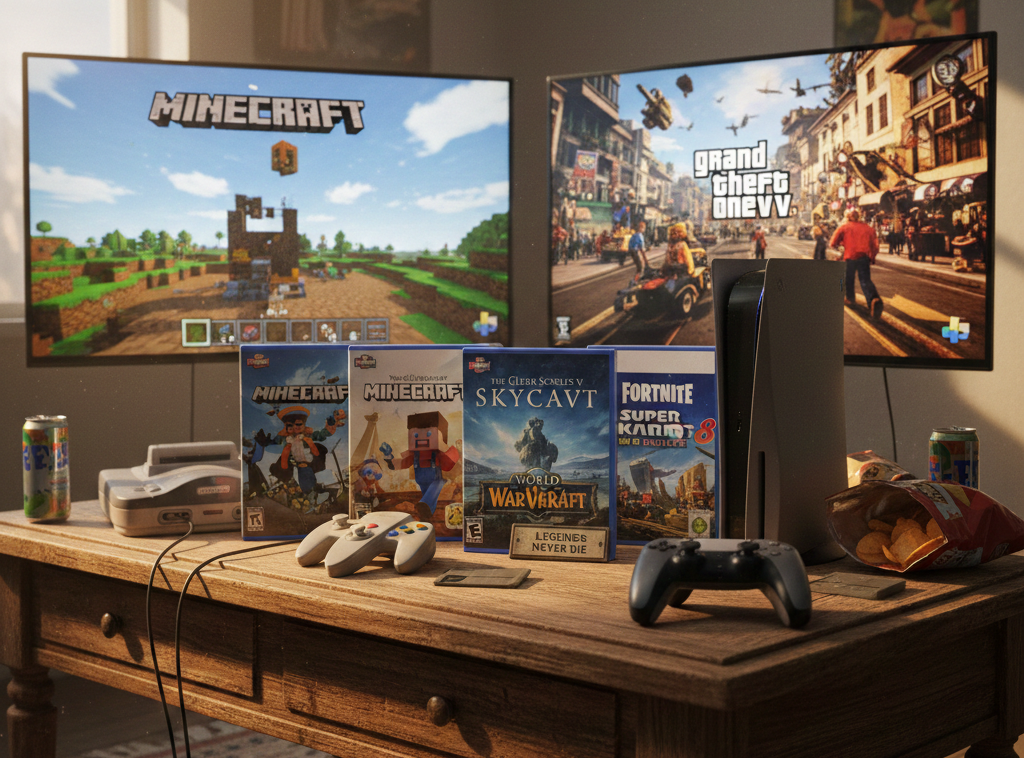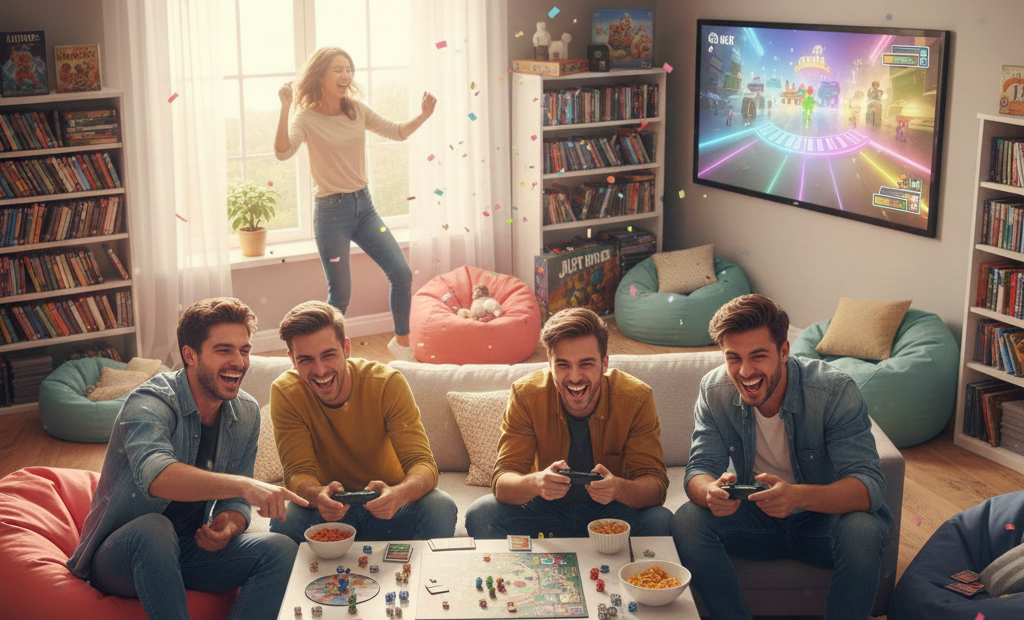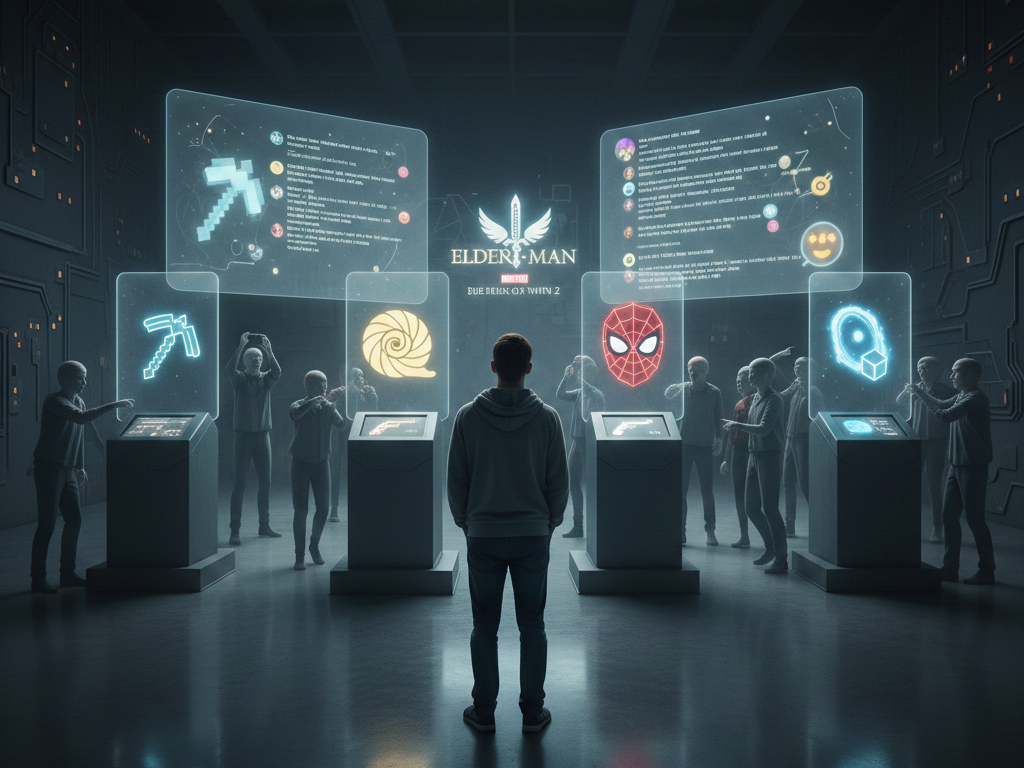Anúncios
Could virtual reality be the key to unlocking newfound independence for stroke survivors? It’s an innovative approach in stroke rehabilitation. VR neurorehabilitation tools are changing the game. They create realistic, interactive environments for patients to engage in meaningful activities.
This active participation is crucial in their recovery journey. Strokes are a leading cause of long-term disability. Effective recovery methods like VR are vital to combat social isolation, depression, and loss of autonomy. VR tools have the power to stimulate neuroplasticity, helping patients recover skills and redefine traditional rehabilitation methods.
Anúncios
Understanding Stroke and Its Impact on Upper Limb Function
Stroke is a serious health issue caused by a blockage in the brain’s blood supply. It can lead to brain damage and disabilities. Hemiplegia, a common result, makes it hard to move one side of the body.
Every year, millions of people suffer from hemiplegia. About 17 million strokes happen worldwide. Two-thirds of survivors face motor impairments, especially in their upper limbs.
These impairments can make daily tasks hard. They affect personal care and complex activities. The loss of independence is a big challenge for many.
Anúncios
Quick and effective treatments are key to improving upper limb function. Studies show that recovery chances drop after three weeks. This highlights the need for early rehabilitation.
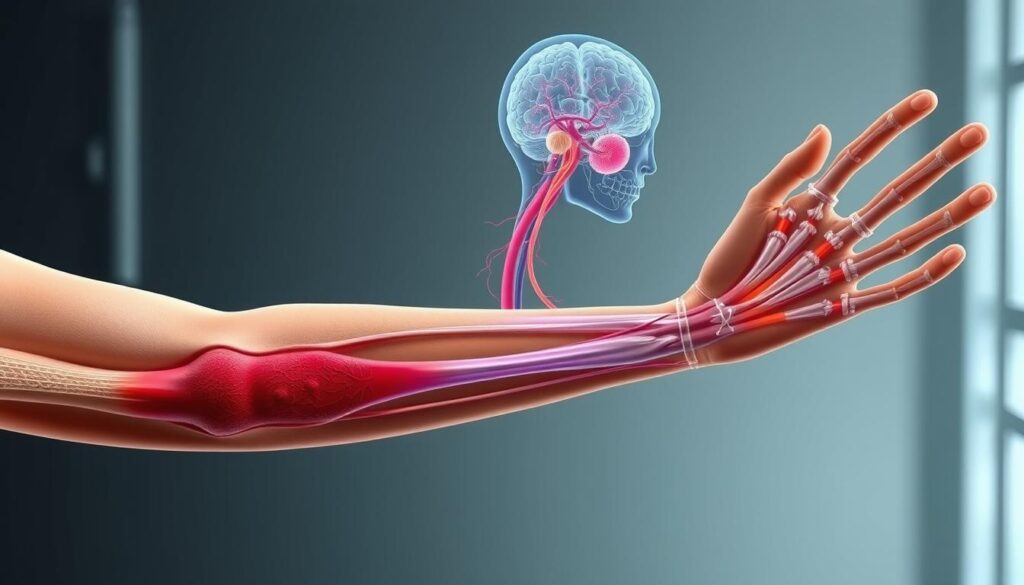
Importance of Upper Limb Rehabilitation in Stroke Recovery
Upper limb rehabilitation is key in stroke recovery. It helps stroke survivors regain control of their arms and hands. This is crucial for doing daily tasks.
Without proper therapy, survivors may face lasting disabilities. This can greatly reduce their quality of life. They often struggle with mobility and independence.
Early interventions in motor relearning and adaptive strategies are vital. Studies show that better upper limb rehab leads to better health overall. Traditional therapy is still effective, but new methods like virtual reality can make rehab more engaging.
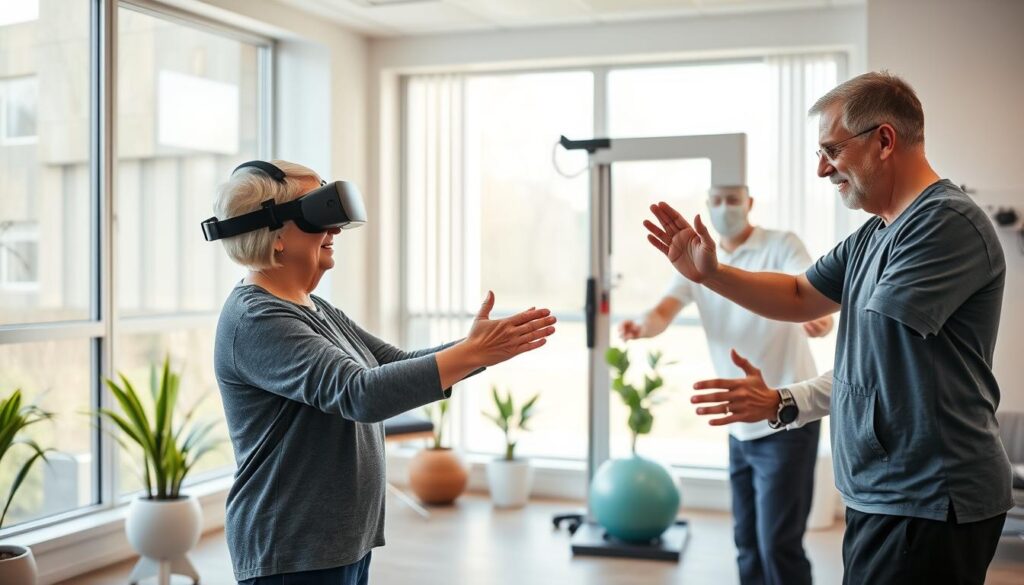
Overview of Virtual Reality in Rehabilitation
Virtual Reality (VR) is changing how we do rehabilitation. It lets patients practice real-life tasks in a safe space. This therapy technology makes exercises fun and helps patients stay motivated.
VR offers many systems for different levels of experience. From simple screens to full-body immersion, there’s something for everyone. This means doctors can create the perfect plan for each patient, making virtual reality rehabilitation very effective.
VR is great because it lets patients train often and in a way that’s just right for them. It’s especially helpful for stroke patients. By practicing in a dynamic environment, patients can improve their motor skills and help their brains heal.
VR Upper Limb Neurorehabilitation Tools for Post-Stroke Recovery
VR tools are changing how we recover from strokes. They help with upper limb recovery. There are many VR systems for different needs, making therapy more effective.
Types of VR Systems Used in Rehabilitation
VR tech for rehab falls into three groups: non-immersive, semi-immersive, and fully immersive. Non-immersive VR uses regular monitors and devices, making it easy to use in clinics. On the other hand, immersive VR offers a more real experience with headsets and controllers.
Each type has its own benefits. It depends on what the patient needs and what the clinic can offer.
| Type of VR System | Hardware Requirements | Level of Immersion | Benefits |
|---|---|---|---|
| Non-immersive VR | Standard computer or console | Low | Cost-effective, widely accessible |
| Semi-immersive VR | Partial VR setups | Medium | Balanced engagement, moderate costs |
| Fully immersive VR | Advanced headsets and sensors | High | Enhanced multi-sensory experience, increased motivation |
Comparison of Non-Immersive and Immersive VR
Choosing between non-immersive and immersive VR depends on how well patients engage and how effective therapy is. Non-immersive VR is simple and affordable, fitting many clinics. Immersive VR, though pricier, boosts motivation and gives better feedback.
Studies show both types work well. The best choice depends on what patients like and what clinics can afford.
Benefits of VR Tools in Enhancing Motor Function
Virtual Reality (VR) tools are changing how we help stroke survivors. They create fun, interactive spaces for patients to practice important skills. This makes them more motivated and engaged than traditional methods.
Improvement of Gross Motor Skills
VR therapy is a big help in improving gross motor skills. It lets patients practice moving in a way that feels real. This is key for doing everyday things.
Studies show VR therapy boosts limb strength and mobility. It helps patients learn to move in a way that’s useful in real life.
Enhancement of Manual Dexterity
Getting better at fine motor skills is a big part of recovery. VR helps with this by making patients practice precise hand movements. This is important for doing things on your own again.
By using VR regularly, stroke survivors can get their hand function back. This is essential for living normally.
Motivational Factors and Patient Engagement in VR Therapy
Motivation is key in therapy, especially after a stroke. Getting patients involved can greatly improve their recovery. VR therapy offers a unique way to boost motivation and engagement.
The Role of Gamification in Therapy
Gamification turns exercises into fun games. It adds challenges, rewards, and scores to make therapy more fun. In VR games, patients get lost in games that help them improve.
This makes them feel accomplished and more engaged. Gamification keeps patients motivated and focused on their recovery.
Impact on Patient Adherence to Rehabilitation Programs
Sticking to therapy is crucial for good results. VR therapy makes therapy more enjoyable, leading to better attendance. Patients find VR less boring than old methods.
This makes them more willing to keep coming back. The VR effect is clear when patients actively work on their recovery. They see better motor skills and progress.
VR Training Techniques to Restore Arm and Hand Movements
VR training is key in stroke rehab for arm and hand recovery. It offers personalized experiences that meet each patient’s needs. This approach boosts the rehab process by focusing on real-life tasks.
Task-Specific Training and Its Importance
Task-specific training is vital in stroke rehab. It lets patients practice movements they use every day. This helps them learn skills that they can use in real life.
These exercises help patients build the motor skills they need. This makes them more independent.
Repetitive and Engaging Activities in VR Environments
Repeating exercises is crucial for muscle memory and motor function recovery. VR environments are made to include fun activities that keep patients motivated. They practice movements over and over, with tasks getting harder as they get better.
This method keeps patients interested and helps them get the most out of their rehab.
Research Evidence Supporting VR Therapy Effectiveness
VR therapy research has shown its power in helping people recover after a stroke. Studies show that VR can make traditional therapy better. It helps improve motor skills, making it a key part of recovery.
Meta-Analyses on VR Outcomes in Upper Limb Recovery
VR meta-analyses show VR is better than old methods for rehab. Patients using VR get better at using their hands and stay more engaged. Reviews highlight VR’s role in helping patients recover their upper limbs after a stroke.
Comparative Studies Between VR and Conventional Therapy
Studies comparing VR and traditional therapy show both have their strengths. While VR alone might not be as good as traditional therapy, combining them boosts results. This mix helps patients get better faster, especially in key motor skills.
Challenges and Limitations in VR Neurorehabilitation
VR neurorehabilitation offers many benefits. But, it faces several challenges that limit its use. It’s important to tackle these issues to fully benefit from this new approach.
Accessibility and Cost Issues
The cost of VR therapy is a big obstacle. It requires a lot of money, which stops many healthcare places from using it. Also, not everyone can get to places with VR therapy.
This makes it hard for those who could really use it. Without the right setup, many miss out on these new treatments.
Individual Variability in Responses to Therapy
How people react to therapy can vary a lot. Things like age and how bad the stroke is can change how well someone recovers. It’s hard to guess who will get the most out of VR therapy.
So, making treatment plans that fit each person’s needs is key. This way, therapy can be more effective for everyone.
The Future of VR in Post-Stroke Neurorehabilitation
The world of neurorehabilitation is changing fast, with VR therapy leading the way for stroke recovery. Researchers and developers are working hard to make VR technology better. This means we could see even more effective treatments soon.
Innovations in VR Technology
New VR systems use artificial intelligence to give feedback and adjust to how well you’re doing. This makes therapy more fun and effective. It also helps make exercises more realistic, which can improve your recovery.
Potential for Home-Based VR Rehabilitation
More people are seeing the value in doing therapy at home. Tele-rehabilitation lets you work on your recovery whenever you want. It also keeps you connected to your healthcare team.
Using VR at home can change how we recover from strokes. It makes therapy more flexible and accessible. This could be a big step forward in rehabilitation.
As VR technology keeps getting better, the future looks bright for stroke recovery. We’re on the path to more precise, engaging, and personalized therapy for those affected by strokes.
Conclusion
VR neurorehabilitation tools are a big step forward in helping stroke survivors regain their upper limb function. These tools not only boost motor skills but also make the recovery process more engaging. They fit well with today’s therapy methods.
Even though there are challenges like access and how each person responds differently, VR’s benefits are clear. These tools are key to a full recovery plan. They make therapy more fun and personalized, helping patients stick with it and see better results.
The future looks bright for VR in neurorehabilitation. It could change how we help people recover from strokes. By using these new technologies, healthcare can offer more hope and support to those recovering from strokes.
FAQ
What is Virtual Reality (VR) neurorehabilitation?
VR neurorehabilitation uses virtual environments to help people recover from strokes. It helps them regain motor functions. This method uses interactive therapy to improve skills and brain flexibility.
How effective is VR therapy for stroke recovery?
Studies show VR therapy boosts upper limb function in stroke survivors. It makes their hands more dexterous. Compared to old methods, VR therapy often leads to better results, especially when used with traditional treatments.
What types of VR systems are used in stroke rehabilitation?
There are different VR systems for rehab. Non-immersive VR uses regular screens. Immersive VR, with headsets and tracking, offers a more engaging experience.
How does gamification enhance VR therapy?
Gamification adds game elements like scores and rewards to VR therapy. It makes rehab more fun. This boosts motivation and helps patients stay involved in their recovery.
What are the benefits of using VR for enhancing motor skills?
VR therapy helps improve motor skills through repetition. It focuses on specific tasks to enhance gross and fine motor skills. This helps patients regain movement and coordination.
Can VR therapy be used at home?
Yes, VR therapy can be done at home. It lets stroke survivors keep up with their therapy on their own. This makes therapy more accessible and allows for remote supervision by doctors.
What challenges does VR neurorehabilitation face?
VR therapy faces challenges like high costs and limited access. It also varies in effectiveness for different patients. Training healthcare providers is another hurdle to widespread use in clinics.
What is the role of task-specific training in VR?
Task-specific training in VR focuses on real-life activities. It’s key for improving daily skills. This targeted approach helps skills learned in VR translate to real life.


